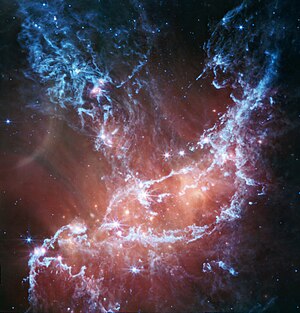NGC 346
| NGC 346 | ||
|---|---|---|

| ||
ジェームズ・ウェッブ宇宙望遠鏡による画像
| ||
| 星座 | きょしちょう座[1] | |
| 位置 元期:J2000.0 | ||
| 赤経 (RA, α) | 00h 59m 05.090s[2] | |
| 赤緯 (Dec, δ) | −72° 10′ 33.24″[2] | |
| 距離 | 21万光年 | |
| 他のカタログでの名称 | ||
| ESO 51-10,[3] N66 | ||
| ■Template (■ノート ■解説) ■Project | ||
NGC 346は、きょしちょう座内に見える小マゼラン雲内にある若い[4]散開星団である。1826年8月1日にスコットランドの天文学者ジェームズ・ダンロップによって発見された。ジョン・ドライヤーは、「明るく、大きく、非常に不規則な形で、中央部がずっと明るく、二重星に似て、まだらだが解像されない程度である」と記述した[5]。星団の外縁部には、小マゼラン雲で最も明るい恒星である恒星系HD 5980がある[6]。
この星団は、N66と呼ばれる小マゼラン雲で最も明るいH II領域の近くにある[7]。銀河の棒状構造の北東部に位置し[8]、この星団の方角に重いOB型星が230個同定されている[4]。星団内の33個の恒星はO型星で、11個O6.5かそれより初期の恒星である[8]。星団の内側の半径15パーセクの領域は、中央に向かって凝集しているように見えるが、その外側は、よりまばらである[9]。中央付近の最も若い恒星は、200万歳以下であり[7]、この星団ではまだ高質量の星形成が行われていると観察される[7]。星形成速度は、1年あたり(4±1)×10−3 M☉と推定される[9]。
アメリカ航空宇宙局のジェームズ・ウェッブ宇宙望遠鏡による2023年の観測[10]で、先例のない洞察が得られた。
この観測により、星団の塵環境に関する驚くべき詳細が明らかとなった。これは、それまでの前提に疑問を呈し、このダイナミックな恒星のゆりかごの中での原始星の形成と初期の惑星系の発展に新たな光を当てるものであり、小マゼラン雲における星形成に関する我々の理解を大きく進め、銀河の形成と進化に関する将来の研究のための新たな道を提供するものである。
-
視野30'のNGC 346の画像の周囲にはうっすらとした星雲構造が見える。
| Walborn | ELS | MPG | NMC | SSN | スペクトル型 | 有効温度 (K) | 絶対等級 | 放射等級 | 質量 (M☉) |
|---|---|---|---|---|---|---|---|---|---|
| 207758 | 755 (HD 5980/AB5) |
LBV WN4 OI |
45,000 45,000 34,000 |
−7.1 (−8.1) −6.8 −6.7 |
−11.135 −10.885 −9.885 |
61 66 34 | |||
| 1 | 435 | 26 | 7 | O5.5If | 43,400 | −6.7 | −10.7 | 91 | |
| 1 | 789 | 5 | O7If | 38,900 | −7 | −10.7 | 85 | ||
| 3 | 355 | 29 | 9 | O3V | 51,300 | −5.7 | −10.3 | 76 | |
| 6 | 7 | 324 | 32 | 13 | O4V | 48,600 | −5.2 | −9.6 | 54 |
| 4 | 342 | 30 | 11 | O5.5V | 44,900 | −5.5 | −9.7 | 53 | |
| 368 | 28 | 15 | O5.5V | 44,900 | −5 | −9.2 | 43 | ||
| 2 | 470 | 25 | O8.5III | 35,700 | −5.4 | −8.9 | 34 |
出典[編集]
- ^ “Hubble Heritage Site”. Results for NGC 346. 2007年4月3日閲覧。
- ^ a b Sturm, R. et al. (October 2013). “The XMM-Newton survey of the Small Magellanic Cloud: The X-ray point-source catalogue”. Astronomy & Astrophysics 558: 31. arXiv:1307.7594. Bibcode: 2013A&A...558A...3S. doi:10.1051/0004-6361/201219935. A3.
- ^ "NGC 346". SIMBAD. Centre de données astronomiques de Strasbourg. 2007年4月17日閲覧。
- ^ a b Dufton, P. L. et al. (February 2020). “The NGC 346 massive star census. Nitrogen abundances for apparently single, narrow lined, hydrogen core burning B-type stars”. Astronomy & Astrophysics 634: 15. arXiv:1912.07539. Bibcode: 2020A&A...634A...6D. doi:10.1051/0004-6361/201936921. A6.
- ^ Seligman, Courtney. “New General Catalogue objects: NGC 300 - 349”. cseligman.com. 2020年9月17日閲覧。
- ^ Nazé, Y. et al. (November 2002). “An X-Ray Investigation of the NGC 346 Field in the Small Magellanic Cloud I. The Luminous Blue Variable HD 5980 and the NGC 346 Cluster”. The Astrophysical Journal 580 (1): 225–234. arXiv:astro-ph/0208289. Bibcode: 2002ApJ...580..225N. doi:10.1086/343079.
- ^ a b c Dufton, P. L. et al. (June 2019). “A census of massive stars in NGC 346. Stellar parameters and rotational velocities”. Astronomy & Astrophysics 626: 28. arXiv:1905.03359. Bibcode: 2019A&A...626A..50D. doi:10.1051/0004-6361/201935415. A50.
- ^ a b Rubio, M. et al. (July 2018). “Massive young stellar objects in the N 66/NGC 346 region of the SMC”. Astronomy & Astrophysics 615: 9. arXiv:1803.10833. Bibcode: 2018A&A...615A.121R. doi:10.1051/0004-6361/201730487. A121.
- ^ a b Hony, S. et al. (April 2015). “Star formation rates from young-star counts and the structure of the ISM across the NGC 346/N66 complex in the SMC”. Monthly Notices of the Royal Astronomical Society 448 (2): 1847–1862. arXiv:1501.03634. Bibcode: 2015MNRAS.448.1847H. doi:10.1093/mnras/stv107.
- ^ “Webb Discovers Star Formation in Dusty Ribbons of a star cluster NGC 346” (英語). www.jameswebbdiscovery.com. 2024年2月20日閲覧。
- ^ Massey, Philip; Waterhouse, Elizabeth; DeGioia-Eastwood, Kathleen (May 2000). “The Progenitor Masses of Wolf-Rayet Stars and Luminous Blue Variables Determined from Cluster Turnoffs. I. Results from 19 OB Associations in the Magellanic Clouds”. The Astronomical Journal 119 (5): 2214–2241. arXiv:astro-ph/0002233. Bibcode: 2000AJ....119.2214M. doi:10.1086/301345. ISSN 0004-6256.
外部リンク[編集]
 ウィキメディア・コモンズには、NGC 346に関するカテゴリがあります。
ウィキメディア・コモンズには、NGC 346に関するカテゴリがあります。- ESA'
- Hubble Heritage site Hubble picture and information on NGC 346
- ESO Beautiful Image of a Cosmic Sculpture
- NASA Astronomy Picture of the Day: Young Stars of NGC 346 (28 September 2008)
- NASA Astronomy Picture of the Day: NGC 346 in the Small Magellanic Cloud (17 October 2010)

